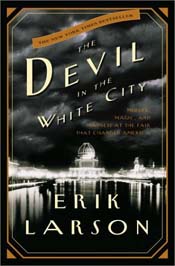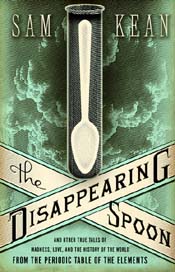For the last week or so I’ve been really in the mood to read, but not so much in the mood to write. But… I’m still like eight reviews behind, so I’m doing my best to kick through the writer’s block and share some book thoughts with you.
Today, two recently nonfiction history books, one that I liked and one that didn’t work as well for me. And they go together because they both have “madness” in the subtitle — a word that I really love.
I present, The Devil in the White City by Erik Larson and The Disappearing Spoon by Sam Kean — You can click the photo to go directly to the review.
 |
 |
The Devil in the White City by Erik Larson
The Devil in the White City: Murder, Magic, and Madness at the Fair That Changed America
In just three years, architect Daniel Burnham and a enormous team of architects, designers, engineers, and day laborers constructed an entire city for the 1893 World’s Fair in Chicago — a feat unmatched before, and probably since. But the White City wasn’t without darkness, both internally and in it’s host city of Chicago, where a serial killer used the event to find his prey.
The first thing I have to note is that Larson heavily, heavily uses foreshadowing in the book, almost to the point of total distraction. This actually bothered me almost entirely to the end of the book.
But other than that style question, I found The Devil in the White City really enjoyable. Larson does a nice job contrasting his two protagonists (a word I use loosely, since one is a murderer) — Daniel Burnham, the heart and mind behind Chicago World’s Fair, and Dr. H. H. Holmes, a psychotic serial killer who built a murder hotel blocks from the fair to lure in unsuspecting female victims.
(Aside: I never imagined I would get to use the phrase “murder hotel” in a review, and I’m kind of excited about it).
The book is a sort of history of the fair/true crime/historical narrative story that is inspiring and creepy as it looks at totally different ways that people go to intense lengths to accomplish what they’re driven to do — create great buildings for one man, or murder people for another. I think this is a nonfiction book definitely worth a look, even if you’re not normally inclined to read the genre.
Rating: 




Edited to Add: Jeanne of Necromancy Never Pays recently reviewed this book, and I think she does a much better job than me of summing it up and sharing details. You should go read her review too 🙂
The Disappearing Spoon by Sam Kean
Sam Kean’s The Disappearing Spoon is a book of stories about the development of the Periodic Table of the Elements — you know, the big chart on the wall of every chemistry classroom in the world used to try and explain how the building blocks of the universe fit together? Actually figuring out the table and discovering all the elements was a major undertaking, and the fact that it has stood the test of time is a testament to the scientists who put it all together.
I loved many of the individual stories Kean shares — a radioactive boyscout, a prosthetic nose of silver, and a blue man to cure syphilis, to name a few — but I struggled with The Disappearing Spoon as a complete book. I wasn’t sold on the organization, which was sort of chronological but did a lot of jumping, nor did I really love the chemistry descriptions. I wasn’t an expert at high school chemistry but I got the basics enough to pull good grades in the class, and yet somehow the descriptions in the book just weren’t clear to me.
By the end, I was feeling more confused than satisfied with the book, which isn’t something I normally feel after reading great nonfiction. If you like chemistry or science or history, I think the book would probably work, but it just felt off for me when I read it.
Rating: 





Comments on this entry are closed.
“Murder hotel” is a good phrase, and a mot juste, in this case! I like the way you give the big picture here–that The Devil in the White City is a book about the lengths some people will go to in order to accomplish their goals–some good, some bad.
Jeanne: It took me awhile to come to some sort of “big picture” for this book – I struggled with trying to explain how the two stories went together for awhile and what sort of opposites Burnham and Holmes were supposed to represent.
I found myself really liking only the half of Devil in the White City that had to do with the world’s fair. And wishing for lots of pictures!
rhapsodyinbooks: I wanted pictures too! I ended up looking up a lot online over the last couple of days, but am still curious.
Both sound interesting but neither sound awesome enough for me to drop everything and go find them 🙂 great reviews, you did a good job of highlighting the good and the bad I think.
Amy: I wouldn’t drop everything for either, but I am glad to have read Devil in the White City and recommend it if you have time, eventually.
Your mini-reviews are as long as my regular reviews! I’ve been excited about The Disappearing Spoon, so I hope it doesn’t leave me confused.
Kathy: That just proves I’m unusually verbose the rest of the time! I really have a hard time writing short 🙂
I don’t think The Disappearing Spoon is that confusing, and even if chemistry doesn’t make sense, it’s really just a minor part of the book and doesn’t take away from the other good stories Kean tells. It mostly bothered me because I used to know how atoms and whatnot worked, and his explanations somehow didn’t work with what I could remember.
I haven’t heard of The Disappearing Spoon before, but I *do* love science and history of science, so it’s definitely going on my wishlist. Thanks for bringing it to my attention!
Fyrefly: I’m glad to point it out to you – I liked lots of parts of the book, the whole just didn’t quite gel for me, but I think it will for a lot of other readers.
I really *want* to read “The Disappearing Spoon,” but I’m sort of worried that too much of it would be over my head. I’m all about history, but have much less of a science background. So conflicted!
Jen: Like I said to Kathy, he really doesn’t spend that much time on the science of how atoms work — just part of the first chapter, then short mentions after that. I think I just got frustrated because I sort of remembered how it all worked, and his explanations weren’t clarifying for me. But I really think that’s just me — many other reviews of the book have praised the clearness of it.
I don’t read tons of non-fiction (as I am always proclaiming), but I have read the Erik Larson novel and did find it really engrossing and just the right amount of creepy. I’m sad to hear you didn’t have as much luck with the Disappearing Spoon – I’ve seen it at my library and thought it looked fun. I do like science, so maybe it would work better for me?
Steph: Devil in the White City is another one of those nonfiction books that seems good for non-nonfiction readers because the story is just so good. You almost forget it’s nonfiction.
As a science person, I think The Disappearing Spoon would be really interesting — at least interesting enough to give it a shot, because it’s certainly not a bad book.
I need to get my hands on The Disappearing Spoon!
Stephanie: I hope you enjoy it!
Devil in the White City is one of my favorites. I can see how the heavy use of foreshadowing could be a bit distracting, though. Glad to see that it worked out for you in the end, though!
Coffee and a Book Chick: The foreshadowing thing certainly wasn’t a deal breaker with the book, just something where when it happened I’d think, “We’re 200 pages into this book – shouldn’t you be telling me the story, not teasing what is going to happen next!?”
If you felt dissatisfied with Kean’s book on the elements you might like to read mine,
Eric Scerri, The Periodic Table, Its Story & Its Significance, Oxford University Press, 2007.
http://www.amazon.com/Periodic-Table-Its-Story-Significance/dp/0195305736/ref=sr_1_1?ie=UTF8&s=books&qid=1288819786&sr=1-1
all the best
eric scerri
Eric: Thanks for the recommendation.
You are quite welcome. Would you be interested in reviewing it perhaps in the way that you did Sam Kean’s book which incidentally I think is excellent. He fully deserves the attention he has been getting with this book.
eric
Eric: Perhaps – I’ll be looking for it at the library and see.
I’ve always wanted to read Devil in the White City, even though true crime isn’t really my thing. I’ve heard it’s well written and accessible, which is good for me when it comes to nonfiction…I tend to shy away from it!
Erin: Yes, I think Devil in the White City is both of those things – it’s definitely a nonfiction books Id suggest for people who don’t normally read nonfiction for those reasons.
I used to read tons of true crime type stories, but as I tend to do, I got overloaded and cut them out completely. That was like two years ago now. I think The Devil in the White City will be what hopefully gets me back into it. 🙂
Trisha: It is easy to get overloaded on true crime – I have to intersperse them with other books or it just gets too dark for me. Devil in the White City is a nice middle book, I think – true crime, plus all the history to balance it out.
Devil in the White City is one I want to read but I know I’ll have to be in the right mood. I’ve thought perhaps listening to it might work out well for me.
Amanda: I think it would be cool to listen to, especially if the narrator was really good.
I didn’t know there was a murder hotel! Hooray! (I mean, not hooray. Of course a murder hotel is very bad. But it sounds extremely interesting.)
Jenny: Ha ha 🙂 That’s what I thought about the phrase “murder hotel” as well.